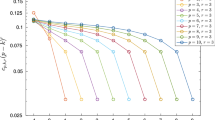Abstract
In this paper we compare the approximation properties of degree p spline spaces with different numbers of continuous derivatives. We prove that, for a given space dimension, \(\mathcal {C}^{p-1}\) splines provide better a priori error bounds for the approximation of functions in \(H^{p+1}(0,1)\). Our result holds for all practically interesting cases when comparing \(\mathcal {C}^{p-1}\) splines with \(\mathcal {C}^{-1}\) (discontinuous) splines. When comparing \(\mathcal {C}^{p-1}\) splines with \(\mathcal {C}^{0}\) splines our proof covers almost all cases for \(p\ge 3\), but we can not conclude anything for \(p=2\). The results are generalized to the approximation of functions in \(H^{q+1}(0,1)\) for \(q<p\), to broken Sobolev spaces and to tensor product spaces.




Similar content being viewed by others
References
Bazilevs, Y., Beirão da Veiga, L., Cottrell, J.A., Hughes, T.J.R., Sangalli, G.: Isogeometric analysis: approximation, stability and error estimates for \(h\)-refined meshes. Math. Models Methods Appl. Sci. 16(7), 1031–1090 (2006)
Beirão da Veiga, L., Buffa, A., Rivas, J., Sangalli, G.: Some estimates for \(h\)–\(p\)–\(k\)-refinement in isogeometric analysis. Numer. Math. 118(2), 271–305 (2011)
Beirão da Veiga, L., Buffa, A., Sangalli, G., Vázquez, R.: Mathematical analysis of variational isogeometric methods. Acta Numer. 23, 157–287 (2014)
Evans, J.A., Bazilevs, Y., Babuška, I., Hughes, T.J.R.: \(n\)-Widths, sup–infs, and optimality ratios for the \(k\)-version of the isogeometric finite element method. Comput. Methods Appl. Mech. Eng. 198(21–26), 1726–1741 (2009)
Floater, M.S., Sande, E.: Optimal spline spaces of higher degree for \(L^2\) \(n\)-widths. J. Approx. Theory 216, 1–15 (2017)
Floater, M.S., Sande, E.: Optimal spline spaces for \(L^2\) \(n\)-width problems with boundary conditions. Constr. Approx. 50, 1–18 (2019)
Hughes, T.J.R., Cottrell, J.A., Bazilevs, Y.: Isogeometric analysis: CAD, finite elements, NURBS, exact geometry and mesh refinement. Comput. Methods Appl. Mech. Eng. 194(39–41), 4135–4195 (2005)
Kolmogorov, A.: Über die beste Annäherung von Funktionen einer gegebenen Funktionenklasse. Ann. Math. 37, 107–110 (1936)
Melkman, A.A., Micchelli, C.A.: Spline spaces are optimal for \(L^2\) \(n\)-width. Ill. J. Math. 22, 541–564 (1978)
Pinkus, A.: \(n\)-Widths in Approximation Theory. Springer, Berlin (1985)
Robbins, H.: A remark on stirling’s formula. Am. Math. Mon. 62(1), 26–29 (1955)
Takacs, S., Takacs, T.: Approximation error estimates and inverse inequalities for B-splines of maximum smoothness. Math. Models Methods Appl. Sci. 26(7), 1411–1445 (2016)
Author information
Authors and Affiliations
Corresponding author
Additional information
Publisher's Note
Springer Nature remains neutral with regard to jurisdictional claims in published maps and institutional affiliations.
The research leading to these results was carried out while both authors were affiliated with the University of Oslo and received funding from the European Research Council under the European Union’s Seventh Framework Programme (FP7/2007-2013)/ERC Grant Agreement 339643.
Appendix
Appendix
Lemma 7
Let \(p\ge 1\) be any odd number. Then the interpolation problem: find \(g \in \mathcal {P}^{p}\) such that for all \(s=0,2,\ldots ,p-1\),
admits a solution for all \(\{a_s\}\), \(\{b_s\}\).
Proof
We proceed by induction on p. If \(p=1\) then the linear interpolant \(g(x)=a_0 + x (b_0-a_0)\) satisfies \(g(0)=a_0\) and \(g(1)=b_0\) and is a solution. Now, let \(p\ge 3\) be any odd number and assume the result is true for \(p-2\). Let \(f\in \mathcal {P}^{p-2}\) be the solution of
which we know exist by the induction hypothesis. We then define the function g by integrating f twice, i.e.,
This function then satisfies the cases \(s\ge 2\) of (22) for all \(c,d\in \mathbb {R}\). We finish the proof by picking the constants c and d such that the case \(s=0\), meaning \(g(0)=a_0\) and \(g(1)=b_0\), is also satisfied. \(\square \)
Lemma 8
Let \(p\ge 0\) be any even number. Then the interpolation problem: find \(g \in \mathcal {P}^{p}\) such that for all \(s=1,3,\ldots ,p-1\),
admits a solution for all \(\{a_s\}\), \(\{b_s\}\).
Proof
For \(p=0\) there is nothing to prove, and so we consider an even number \(p\ge 2\). We then let \(f\in \mathcal {P}^{p-1}\) be the solution of
which we know exist by Lemma 7. The function \(g(x)=c+\int _0^xf(y)dy\) is then a solution of (23) for any \(c\in \mathbb {R}\). \(\square \)
Rights and permissions
About this article
Cite this article
Bressan, A., Sande, E. Approximation in FEM, DG and IGA: a theoretical comparison. Numer. Math. 143, 923–942 (2019). https://doi.org/10.1007/s00211-019-01063-5
Received:
Revised:
Published:
Issue Date:
DOI: https://doi.org/10.1007/s00211-019-01063-5




